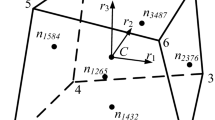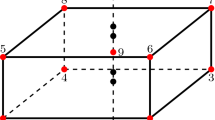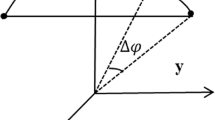Abstract
In this paper, two eight-node asymmetric solid-shell elements are firstly presented to illustrate the use of traditional finite element technique in GMEM for constructing new finite element formulations. In these two elements, the analytical method is utilized to derive the displacement functions of the basic in-plane modes, which makes the resulted elements free of mesh distortions for these modes. For out-of-plane modes, the Mindlin plate elements CQUAD4 and QTS4 are integrated to calculate the corresponding modal displacement vectors and modal force vectors of solid-shell elements. As a result, the displacement functions of the plate-bending element range up to three orders of magnitude. On the other hand, since the asymmetric elements cannot be applied to frequency analysis, two symmetric solid-shell elements are proposed by using a modal transformation method, in which the in-plane modes are derived from the previous proposed symmetric solid element S-MEM8S and the out-of-plane modes are constructed by plate elements CQUAD4 and QTS4, respectively. Various benchmarks including linear static and frequency analysis are presented to demonstrate the accuracy and efficiency of the presented elements.





























Similar content being viewed by others
References
Ahmad S, Irons BM, Zienkiewicz OC (1970) Analysis of thick and thin shell structures by curved finite elements. Int J Numer Meth Eng 2:419–451
Ziyaeifar M, Elwi AE (1996) Degenerated plate-shell elements with refined transverse shear strains. Comput Struct 60:1079–1091
Bathe KJ, Dvorkin EN (1986) A formulation of general shell elements-the use of mixed interpolation of tensorial components. Int J Numer Meth Eng 22:697–722
Liu WK, Law ES, Lam D et al (2016) Resultant-stress degenerated-shell element. Comput Methods Appl Mech Eng 55(3):259–300
Cheung YK, Chen W (1990) Generalized hybrid degenerated elements for plates and shells. Comput Struct 36:279–290
Parisch H (1995) A continuum-based shell theory for non-linear applications. Int J Numer Meth Eng 38:1855–1883
Wriggers P, Eberlein R, Reese S (1996) A comparison of three-dimensional continuum and shell elements for finite plasticity. Int J Solids Struct 33:3309–3326
Miehe C (1998) A theoretical and computational model for isotropic elastoplastic stress analysis in shells at large strains. Comput Meth Appl Mech Eng 155:193–233
Hauptmann R, Schweizerhof K (1998) A systematic development of ‘solid-shell’ element formulations for linear and non-linear analyses employing only displacement degrees of freedom. Int J Numer Meth Eng 42:49–69
Hauptmann R, Schweizerhof K, Doll S (2000) Extension of the ‘solid-shell’ concept for application to large elastic and large elastoplastic deformations. Int J Numer Meth Eng 49:1121–1141
Alves De Sousa RJ, Cardoso RPR, Fontes VRA et al (2005) A new one-point quadrature enhanced assumed strain (EAS) solid-shell element with multiple integration points along thickness: Part I—geometrically linear applications. Int J Numer Meth Eng 62:952–977
Kulikov GM, Plotnikova SV (2006) Geometrically exact assumed stress–strain multilayered solid-shell elements based on the 3D analytical integration. Comput Struct 84:1275–1287
Cardoso RPR, Yoon JW, Mahardika M, Choudhry S, Alves de Sousa RJ, Fontes Valente RA (2008) Enhanced assumed strain (EAS) and assumed natural strain (ANS) methods for one-point quadrature solid-shell elements. Int J Numer Meth Eng 75:156–187
Andelfinger U, Ramm E (1993) EAS-elements for two-dimensional, three-dimensional, plate and shell structures and their equivalence to HR-elements. Int J Numer Meth Eng 36:1311–1337
Areias PMA, Cesar de Sá JMA, Conceicão António CA, Fernandes AA (2003) Analysis of 3D problems using a new enhanced strain hexahedral element. Int J Numer Meth Eng 58:1637–1682
Sze KY, Yao LQ (2000) A hybrid stress ANS solid-shell element and its generalization for smart structure modelling, Part I—solid-shell element formulation. Int J Numer Meth Eng 48:545–564
Sze KY, Yao LQ, Pian T (2002) An eighteen-node hybrid-stress solid-shell element for homogenous and laminated structures. Finite Elem Anal Des 38:353–374
Zienkiewicz OC, Taylor RL, Too JM (1971) Reduced integration technique in general analysis of plates and shells. Int J Numer Methods Eng 3:275–290
Hughes TJR, Cohen M, Haroun M (1978) Reduced and selective integration techniques in finite element analysis of plates. Nuclear Eng Des 46:203–222
Caseiro JF, De Sousa RJA, Valente RAF (2013) A systematic development of EAS three-dimensional finite elements for the alleviation of locking phenomena. Finite Elem Anal Des 73:30–41
Belytschko T, Ong SJ, Liu WK et al (1984) Hourglass control in linear and nonlinear problems. Comput Methods Appl Mech Eng 43(3):251–276
Liu WK, Hu Y, Belytschko T (2010) Multiple quadrature underintegrated finite elements. Int J Numer Meth Eng 37(19):3263–3289
Flanagan DP, Belytschko T (2010) A uniform strain hexahedron and quadrilateral with orthogonal hourglass control. Int J Numer Meth Eng 17(5):679–706
Alves de Sousa RJ, Natal Jorge RM, Fontes Valente RA, Cesar de Sá JMA (2003) A new volumetric and shear locking-free 3D enhanced strain element. Eng Comput 48:896–925
Korelc J, Wriggers P (1996) An efficient 3D enhanced strain element with Taylor expansion of the shape functions. Comput Mech 19:30–40
de Souza Neto EA, Peric D, Huang GC, Owen DRJ (1995) Remarks on the stability of enhanced strain elements in finite elasticity and elastoplasticity. Commun Numer Meth Eng 11:951–961
Fontes Valente RA, Alves de Sousa RJ, Natal Jorge RM (2004) An enhanced strain 3D element for large deformation elastoplastic thin-shell applications. Comput Mech 34:38–52
Hughes TJR, Tezduyar TE (1981) Finite elements based upon Mindlin plate theory with particular references to the four node bilinear iso-parametric element. J Appl Mech 48:587–595
Schwarze M, Reese S (2009) A reduced integration solid-shell finite element based on the EAS and the ANS concept-geometrically linear problems. Int J Numer Meth Eng 80:1322–1355
Betsch P, Stein E (1995) An assumed strain approach avoiding artificial thickness straining for a non-linear 4-node shell element. Commun Numer Meth Eng 11:899–909
Hughes TJR, Cottrell JA, Bazilevs Y (2005) Isogeometric analysis: CAD, finite elements, NURBS, exact geometry and mesh refinement. Comput Methods Appl Mech Eng 194(39–41):4135–4195
Zhang G, Khandelwal K (2016) Modeling of nonlocal damage-plasticity in beams using isogeometric analysis. Comput Struct 165:76–95
Greco F, Rosolen A, Coox L et al (2017) Contact mechanics with maximum-entropy meshfree approximants blended with isogeometric analysis on the boundary. Comput Struct 182:165–175
Hosseini S, Remmers JJC, Verhoosel CV et al (2013) An isogeometric solid-like shell element for nonlinear analysis. Int J Numer Meth Eng 95(3):238–256
MacNeal RH (1978) A simple quadrilateral shell element. Comput Struct 8:175–183
MacNeal RH (1994) Finite elements: their design and performance. M. Dekker, New York, pp 406–410
Zhen Wang (2014) Corotational nonlinear analyses of laminated shell structures using a 4-node quadrilateral flat shell element with drilling stiffness. Acta Mech Sin 30(3):418–429
Timoshenko S, Goodier JN (1951) Theory of elasticity. McGraw-Hill, New York
Nastran MSC (2012) Linear Static Analysis User’s Guide. The MacNeal-Schwendler Corporation, Santa Ana, CA
MacNeal RH, Harder RL (1985) A proposed standard set of problems to test finite element accuracy. Finite Elem Anal Des 1:3–20
Simo JC, Rifai MS (1990) A class of mixed assumed strain methods and the method of incompatible modes. Int J Numer Meth Eng 29:1595–1638
Fredriksson M, Ottosen NS (2007) Accurate eight-node hexahedral element. Int J Numer Meth Eng 72:631–657
Inc ABAQUS (2004) ABAQUS Documentation Version 6.5. ABAQUS Inc., Pawtucket
Wilson EL, Taylor RL, Doherty WP, Ghaboussi J (1973) Incompatible displacement models. Academic Press, New York
Cao C, Qin Q-H, Yu A (2012) A new hybrid finite element approach for three-dimensional elastic problems. Arch Mech 64:261–292
Gruttmann F, Wagner W (2005) A linear quadrilateral shell element with fast stiffness computation. Comput Meth Appl Mech Eng 194:4279–4300
Mostafa M, Sivaselvan MV, Felippa CA (2013) A solid-shell corotational element based on ANDES, ANS and EAS for geometrically nonlinear structural analysis. Int J Numer Meth Eng 95:145–180
Mostafa M (2016) An improved solid-shell element based on ANS and EAS concepts. Int J Numer Meth Eng 108(11):1362–1380
Simo JC, Fox DD, Rifai MS (1989) On a stress resultant geometrically exact shell model-Part II: the linear theory-computational aspects. Comput Methods Appl Mech Eng 73:53–92
Cardoso RPR, Yoon JW, Grácio JJ, Barlat F, Césarde Sá JMA (2002) Development of one point quadrature shell element for nonlinear application with contact and anistropy locking for one point quadrature shell elements linear formulation. Comput Meth Appl Mech Eng 191:5177–5206
Valente RAF, NatalJorge RM, Cardoso RPR, Césarde Sá JMA, Grácio JJ (2003) On the use of an enhanced transverse shear strain shell element for problems involving large rotations. Comput Mech 30:286–296
Korelc J (1996) Symbolic approach in computational mechanics and its application to the enhanced strain method. Ph.D. Thesis, University of Darmstadt, Germany
Edem IB, Gosling PD (2012) One-point quadrature ANS solid-shell element based on a displacement variational formulation Part I-Geometrically linear assessment. Comput Meth Appl Mech Eng 237:177–191
Liu WK, Hu YK, Belytschko T (1994) Multiple quadrature underintegrated finite elements. Int J Numer Meth Eng 37:3263–3289
Liu WK, Guo Y, Tang S, Belytschko T (1998) A multiple-quadrature eight-node hexahedral finite element for large deformation elastoplastic analysis. Comput Meth Appl Mech Eng 154:69–132
Li Q, Liu Y, Zhang Z et al (2015) A new reduced integration solid-shell element based on EAS and ANS with hourglass stabilization. Int J Numer Meth Eng 104:805–826
Alves de Sousa RJ, Natal Jorge RM, Fontes Valente RA, Cesar de Sá JMA (2003) A new volumetric and shear locking-free 3D enhanced strain element. Eng Comput 20:896–925
Reese S (2007) A large deformation solid-shell concept based on reduced integration with hourglass stabilization. Int J Numer Meth Eng 69:1671–1716
Norachan P, Suthasupradit S, Kim K (2012) A co-rotational 8-node degenerated thin-walled element with assumed natural strain and enhanced assumed strain. Finite Elem Anal Des 50:70–85
Li HG, Cen S, Cen ZZ (2008) Hexahedral volume coordinate method (HVCM) and improvements on 3D Wilson hexahedral element. Comput Methods Appl Mech Eng 197(51):4531–4548
Acknowledgements
This research was supported by the National Natural Science Foundation of China (Nos. 51375386 and 11602286).
Author information
Authors and Affiliations
Corresponding author
Rights and permissions
About this article
Cite this article
He, P.Q., Sun, Q. & Liang, K. Generalized modal element method: part II—application to eight-node asymmetric and symmetric solid-shell elements in linear analysis. Comput Mech 63, 783–804 (2019). https://doi.org/10.1007/s00466-018-1622-5
Received:
Accepted:
Published:
Issue Date:
DOI: https://doi.org/10.1007/s00466-018-1622-5




